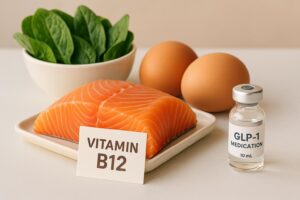What Foods Contain GLP-1 and How They Can Support Your Weight Loss Journey

Introduction
Have you ever wondered why some foods keep you feeling fuller for longer while others leave you reaching for another snack just moments after eating? The answer lies in a remarkable hormone known as glucagon-like peptide-1 (GLP-1). This hormone plays a pivotal role in regulating blood sugar levels, appetite, and overall metabolic health. As we navigate our weight loss journeys, understanding the connection between our dietary choices and GLP-1 levels can be a game changer.
In recent years, the role of GLP-1 has gained traction, particularly due to its association with popular medications like semaglutide, which mimic its effects. However, we believe that you can harness the power of food to naturally increase GLP-1 levels without relying solely on medication. This blog post aims to explore what foods contain GLP-1 and how incorporating them into our diets can support our weight loss goals and enhance our overall well-being.
We will delve into the foods that stimulate GLP-1 secretion, the science behind how they work, and practical tips for integrating these foods into your daily meals. By the end of this post, we hope to empower you with the knowledge to make informed dietary choices that align with your health goals. Together, let’s embark on this journey to uncover the potential of GLP-1 and the foods that can help elevate its levels in our bodies.
Understanding GLP-1: A Key Player in Metabolism
To fully appreciate the impact of diet on GLP-1 levels, it’s essential to understand what GLP-1 is and how it functions. GLP-1 is an incretin hormone produced in the intestines in response to food intake. Its primary roles include:
-
Stimulating Insulin Secretion: When we eat, GLP-1 signals the pancreas to release insulin, a hormone that helps lower blood sugar levels by facilitating the uptake of glucose into cells.
-
Inhibiting Glucagon Release: Glucagon is another hormone that raises blood sugar levels. GLP-1 suppresses glucagon secretion, which further aids in maintaining balanced blood sugar levels.
-
Slowing Gastric Emptying: GLP-1 slows down the rate at which food leaves the stomach, promoting a longer-lasting feeling of fullness.
-
Regulating Appetite: By acting on the brain’s appetite control centers, GLP-1 helps reduce hunger and cravings, making it easier to manage portion sizes and avoid overeating.
Research has shown that higher levels of GLP-1 are associated with better weight management and improved metabolic health, making it a vital hormone for those looking to lose weight or maintain a healthy lifestyle.
Foods That Naturally Increase GLP-1 Levels
Now that we understand the importance of GLP-1, let’s explore the types of foods that can help stimulate its production. A diet rich in fiber, healthy fats, and lean proteins plays a crucial role in enhancing GLP-1 levels.
1. High-Fiber Foods
Fiber is a powerhouse nutrient that not only supports digestive health but also promotes GLP-1 secretion. When fiber is fermented by gut bacteria, it produces short-chain fatty acids (SCFAs) that stimulate the release of GLP-1. Here are some fiber-rich foods to consider:
-
Whole Grains: Foods like oats, barley, and whole wheat are rich in soluble fiber, which helps slow digestion and promotes a gradual release of glucose into the bloodstream. This, in turn, stimulates GLP-1 secretion.
-
Fruits: Apples, pears, berries, and citrus fruits are not only delicious but also high in fiber. They can provide the necessary nutrients to enhance GLP-1 levels.
-
Vegetables: Leafy greens, broccoli, Brussels sprouts, and carrots are all excellent sources of fiber and vitamins that can positively influence GLP-1 secretion.
-
Legumes: Beans, lentils, and peas are packed with fiber and protein, making them an ideal choice for increasing GLP-1 levels.
2. Healthy Fats
Incorporating healthy fats into our diets can also help boost GLP-1 secretion. Unsaturated fats, particularly those found in certain oils and seeds, play a significant role in this process:
-
Avocado: Rich in monounsaturated fats and fiber, avocados have been shown to enhance GLP-1 levels while reducing insulin levels after meals.
-
Olive Oil: Extra virgin olive oil is a fantastic source of healthy fats that can stimulate GLP-1 release more effectively than saturated fats found in butter.
-
Nuts and Seeds: Almonds, walnuts, flaxseeds, and chia seeds are excellent sources of healthy fats and fiber that can contribute to increased GLP-1 secretion.
3. Lean Proteins
Protein is another crucial nutrient that can stimulate GLP-1 production. Foods high in protein not only provide essential amino acids but also promote satiety:
-
Eggs: Eggs are an excellent source of protein and healthy fats. Research indicates that meals rich in eggs can lead to higher GLP-1 levels and increased feelings of fullness.
-
Fish: Fatty fish like salmon and mackerel are rich in omega-3 fatty acids, which have been associated with enhanced GLP-1 secretion.
-
Poultry: Lean meats such as chicken and turkey provide high-quality protein that can stimulate GLP-1 release.
4. Foods Rich in Fermentable Fibers
Certain types of fiber are more effective at promoting GLP-1 secretion due to their fermentable properties. These include:
-
Beta-Glucan: Found in oats and barley, this soluble fiber has been shown to increase GLP-1 levels and improve insulin sensitivity.
-
Resistant Starch: Foods like cooked and cooled potatoes, green bananas, and legumes contain resistant starch that can boost GLP-1 production.
The Science Behind Food and GLP-1 Secretion
Understanding how these foods influence GLP-1 secretion is crucial for optimizing our diets. When we consume meals rich in fiber, healthy fats, and proteins, specific nutrients trigger the release of GLP-1 from the intestinal cells. This process involves several steps:
-
Nutrient Detection: As food is digested, certain macronutrients such as carbohydrates, proteins, and fats are detected by specialized cells in the gut.
-
Hormonal Response: These cells release GLP-1 into the bloodstream, where it travels to the pancreas and other organs to exert its effects.
-
Microbiome Interaction: The gut microbiome plays a vital role in this process. When we consume fiber, gut bacteria ferment it into SCFAs, which further stimulate GLP-1 secretion.
The Role of Gut Health in GLP-1 Production
Maintaining a healthy gut microbiome is essential for optimal GLP-1 production. A diverse and balanced gut microbiome can enhance the fermentation of dietary fiber, leading to increased SCFA production and, consequently, higher GLP-1 levels. Here are some tips for supporting gut health:
-
Incorporate Prebiotics: Foods rich in prebiotic fibers, such as garlic, onions, and asparagus, can feed beneficial gut bacteria and promote SCFA production.
-
Consider Probiotics: Probiotic-rich foods like yogurt, kefir, and fermented vegetables can help maintain a healthy gut microbiome.
-
Mindful Eating: Slower, more mindful eating can enhance gut health and promote better digestion, leading to improved GLP-1 secretion.
Practical Tips for Incorporating GLP-1-Boosting Foods
Now that we understand the foods that can help boost GLP-1 levels, let’s discuss some practical ways to incorporate these foods into our daily meals:
-
Start Your Day with High-Fiber Breakfast: Consider oatmeal topped with fresh fruit and nuts or a veggie-packed omelet with avocado on the side.
-
Snack Smart: Choose snacks like apple slices with almond butter or hummus with carrot sticks to keep your energy levels stable and support GLP-1 production.
-
Balanced Lunches: Create balanced meals that include lean proteins, whole grains, and plenty of vegetables. A quinoa salad with grilled chicken and mixed greens is a great option.
-
Healthy Dinners: Opt for meals that feature fatty fish, roasted vegetables, and whole grains. A salmon fillet served with barley and steamed broccoli is both nutritious and satisfying.
-
Mind Your Portions: Eating slowly and mindfully can help you tune into your body’s hunger signals, allowing GLP-1 to do its job effectively.
Conclusion
Understanding what foods contain GLP-1 and how they can influence our weight loss journey is essential for achieving sustainable results. By focusing on high-fiber foods, healthy fats, and lean proteins, we can naturally stimulate GLP-1 secretion and support our metabolic health. Remember, incorporating these foods into our diets is not just about boosting GLP-1; it’s about nurturing our overall well-being.
As we continue to learn about the powerful connection between diet and hormones, we invite you to reflect on your own eating habits. Are there ways you can enhance your meals with GLP-1-boosting foods? By making mindful changes to our diets, we can take meaningful steps toward achieving our health goals.
FAQ
What is GLP-1 and why is it important?
GLP-1 is a hormone produced in the intestines that plays a crucial role in regulating blood sugar levels, appetite, and satiety. It stimulates insulin secretion, inhibits glucagon release, and slows gastric emptying.
How can I naturally increase GLP-1 levels through my diet?
Incorporating high-fiber foods, healthy fats, and lean proteins into your meals can stimulate GLP-1 secretion. Foods like whole grains, fruits, vegetables, nuts, seeds, and lean meats are great choices.
What are some examples of high-fiber foods?
Examples of high-fiber foods include oats, barley, beans, lentils, apples, pears, and various vegetables like broccoli and Brussels sprouts.
Can gut health affect GLP-1 production?
Yes, a healthy gut microbiome enhances the fermentation of dietary fibers, leading to increased production of short-chain fatty acids (SCFAs) that stimulate GLP-1 secretion.
Is it necessary to take GLP-1 medications to manage weight?
While GLP-1 medications can be effective for some individuals, dietary changes that promote natural GLP-1 production can also significantly support weight management and overall health.
By embracing these dietary strategies and understanding the role of GLP-1, we can take charge of our health and work towards sustainable weight loss goals. Together, we can make informed choices that benefit our bodies and enhance our well-being.

Transforming Lives, One Step at a Time
Keep reading
Vitamin B12 and GLP-1 Medications: What to Know
GLP-1 medications can lower B12 absorption and intake; learn symptoms, food sources, supplement options, and how to monitor levels.
Semaglutide Injection Site Reactions: What To Know
Learn why semaglutide injections can cause redness, swelling or nodules, how to prevent and treat them, and when to seek medical care.
TrimRx vs Friday’s
Compare TrimRx and Friday’s telehealth GLP-1 weight-loss programs: pricing, medical support, coaching, delivery, and which fits your needs.



